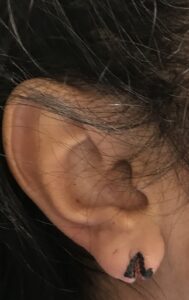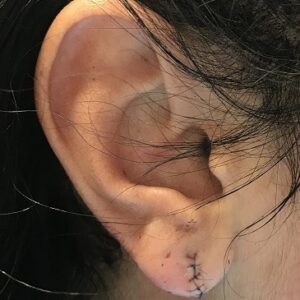Minor Surgery
Cyst Removal
Cysts that form under the skin are very common and can occur in any part of the body. They are usually filled with a thick white or yellow fluid, which can sometimes be fowl smelling. This fluid is because of the secretions of the skin. Sometimes they discharge spontaneously, and sometimes they get infected. They can be confused with lipomas. Treatment is surgical remocal, leaving behind a small scar.


split & stretched earlobe
Ear lobes may split or stretch with time after use of ear rings or after injury. This can result in either a split ear lobe or widened piercing hole. Regard less of the reason, it is possible to carry out a plastic surgical procedure on the earlobe to repair it. Specialist techniques such as using rotation flaps may needed for earlobe repairs. This may help aid a more rapid recovery and ability to wear earrings earlier.
Mole excision
Most moles are benign or non-cancerous. Mole removal may be performed for cosmetic reasons or if there are any concerns about a mole. Excision of a mole is when the entire mole is removed and the skin closed with sutures. This is different from a shave excision. If there is concern about the mole it should be excised.
"The Best Experience Ever"

Start with a virtual consultation
Shave Treatments
As opposed to the excision treatment described above, a shave excision involves shaving a raised mole flush with the skin. This can only be done on benign moles. There will be a scar where the mole has been removed usually the size and shape of the mole. The scar will initially be red but should settle over a few months. This method removes only the raised part of the mole and so the roots may still be present. There is, therefore, a risk of recurrence or the mole growing back.
Laser Treatments
Laser mole removal involves using a special laser, either an erbium or CO2 laser, to remove the mole. This technique essentially burns the mole layer by layer until it is flush with the skin surface. The resultant scar is similar to that of a shave excision. It is generally a mark which is similar in shape and size to that of the mole. Laser does not allow for any specimens to be sent for histology and so is not recommended if we are concerned about changes in a mole. There is a risk of recurrence.
Lumps & Bumps
Lipoma
These are fatty lumps under the skin. They grow slowly over time and are painless to the patient and not tender to touch. They can occur in any part of the body. Lipomas can be removed by surgical excision or liposuction.
Milia
Milia are very small, raised, pearly-white or yellowish bumps on the skin. They are most often seen on the skin around the cheeks, nose, eyes and eyelids, forehead and chest. However, they can occur anywhere on the body. They are a type of tiny skin cyst filled with a protein called keratin. Treatment is to remove them individually using a hyfrecator machine.
SKIN tag
Skin tags are harmless skin growths that may be flesh coloured or brown. They are most commonly found around the neck, armpits, groins, trunk and around the eyes. They vary in size from very small ones up to larger skin tags. Skin tags can become troublesome when they catch on clothing or jewellery. This can result in bleeding of the skin tags. They can be easily removed by freezing or by excision leaving hardly any marks.
Reviews
What our patients say

tattoo excision
Some people might regret having some tattoos and wish them to be removed. The most common method of tattoo removal remains by the use of lasers. Advances in laser technology include pico second lasers. These can reduce the number of sessions required. Laser tattoo removal will often need multiple sessions over long periods of time.
For certain tattoos, surgical excision of tattoos may be an option. This method will completely remove the tattoo if possible or it may require staged multiple procedures for larger tattoos. There will be a permanent resultant scar in place of the tattoo. The scars will fade with time but will always be present.
Elective surgery most often leave neat scars behind. However sometimes that’s not the case such as if there is a complication, following trauma or a burn. Scars can be problematic, unsightly, raised or remain red. Sometimes scars can be hypertrophic scars that may be raised, red or wide but within the boundaries of the existing scar. In other situations, scars can be keloid scars that may be large and raised but also grow beyond the boundaries of the original scar. There are some risk factors for developing keloid scars that include dark skin types and particular areas of the body such as ears, shoulders, and chest. There may be hereditary or genetic factors in developing these scars.
These types of scars can be very difficult to treat. The usual first line for treatment of hypertrophic scars is to massage and protect from the sun. If that fails, then the use silicone gels and sheets to cover the scars may help reduce redness of scars and can help reduce their size if used regularly. In addition to that specialists’ pressure garments can be created. The next step for managing difficult scars is the use of steroid injections. Finally lasers or peels can be used to help with the colour or irregularities.
Steroid injections can help reduce redness and size of these scars as well as the itching sensation that these scars can have. Patients will often need a course of steroid injections to see the benefits of treatment. Injections can be repeated every 4-6 weeks.
Surgical correction of scars is possible but it is essential you speak to a plastic surgeon specialised in scar management. Dr Souéid in addition to being an aesthetic plastic surgeon, he is also a burn surgeon specialising in scar management. He can build with you a strategy to manage your scars using advanced tissue engineering techniques.
Complex Scar Management
By Dr Ali Soueid
Consultant Burn & Plastic Surgeon

Inverted nipple correction
An inverted nipple is a medical condition in which the nipple is pulled inwards, as opposed to the normal position of pointing outwards. There are many causes including duct, fibrosis, congenital, infections, and some types of breast cancers. It is important to exclude the last cause before having surgery. It is classified into 3 grades. Grade 1 is when the nipple can be corrected by stimulus, grade 2 is when the nipple corrects by massaging and grade 3 never corrects. Some people use suction cups if the condition is transient, however for chronic cases then surgical correction is needed. There are several techniques, the most popular being the “Trampoline Technique”. In this sutures are used to suspend the nipple. Other techniques include injection of fat or using dermal flaps.
HealthFormation

signs of skin cancer
Size – if a mole is more than 5mm in size or if it has grown in size. Shape – if the mole is irregular. Border – if there are irregular borders Colour – if there has been a change in colour or if the mole has variation in colour within it. Bleeding – if there has been bleeding without injury. Itching – if a mole has developed itchiness
Sun protection
Excessive sun exposure contributes to a lot of skin cancers. Look after your skin with a sun screen.
WART Treatment
We can treat warts using surgery, cryotherapy or laser..
Choose Your treatment
Wart
From £150
Tattoo Excision
From £600
Inverted Nipple
From £900
 BEFORE
BEFORE
 AFTER
AFTER
 BEFORE
BEFORE
 AFTER
AFTER
 BEFORE
BEFORE
 AFTER
AFTER
Frequently asked questions
Minor surgical procedures are performed as outpatient procedures under local anaesthetic. The local anaesthetic can be either a cream or an injection and that helps to numb the area to allow the procedure to be performed.
Some procedures will need sutures some will not. If not sutures are involved then a small dressing is applied which can be removed in 24 hours and an antibiotic ointment is used. Sometimes a dressing is required for longer. Dr Souéid will advise you. If the procedure will involve stitching, then the stitches will normally stay in for a week or two (Dr Souéid will advise you) and then you will have them removed. The wound will then go through stages of wound healing that means that it will change from looking red to gradually fading with time. We say it takes up to 18 months for a scar to fully settle.
Generally it is recommended that you should wait about 4 months before having a repeat piercing.
There are things you can do to help the scar settle more quickly. Massage the scar once healed with a bioactive cream. Use suncream twice a day for 12 monhs. You can use a silicone based scar cream daily for 4 months.
Scarring
All methods of surgery will leave some form of a permanent scar.
Infection
Infection is uncommon but can occur.
Bleeding
Some bleeding or oozing can be expected. This usually stops quickly with a little pressure to the area.
Incomplete excision
Some techniques such as shave excision or laser mole removal may not fully remove the mole. This is also the case with surgical excision although the likelihood of incomplete excision with surgical excision is less common.
Recurrence
There is a risk of the recurrence.
do you have more questions about minor surgery?






Seen Something Interesting?
We know you are busy, but do not leave without saying Goodbye! If you are interested in our services, simply click below and fill a 10 second quick enquiry, and we will get back to you within 24 hours.
Get in Touch
hello@cosmeticaestheticplasticsurgery.com

